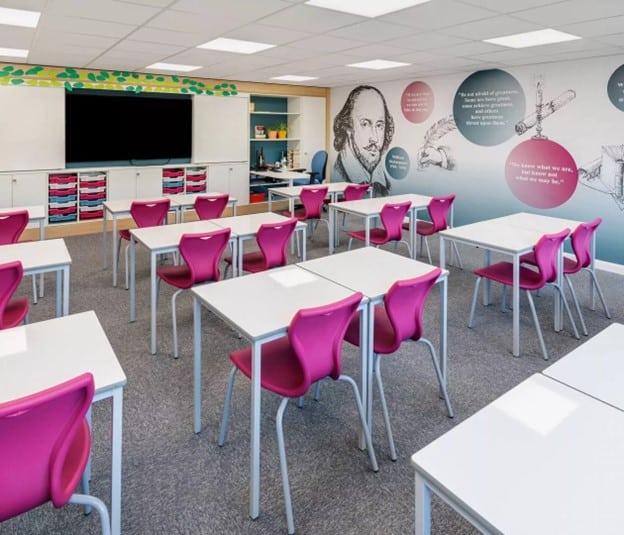Exploring the Diverse Design Styles and Options of Teaching Walls
May 14, 2024 • 6 minutes

A productive learning environment is largely dependent on the design and arrangement of classrooms in the dynamic field of education. Using teaching walls is one creative idea that has been really popular recently. These adaptable buildings give both teachers and students a host of advantages in addition to serving as the classroom’s focal point. These fixtures come in a variety of styles that adapt to the unique requirements of any educational location, from conventional designs to contemporary and cutting-edge solutions.
The importance of design in educational spaces
Practicality and beauty are complementary elements in school interior design. The arrangement of a classroom has a big influence on the whole learning process. Research has shown that carefully designed learning spaces can enhance academic attainment, foster teamwork, and increase involvement. A classroom that is purposefully designed to foster creativity and critical thinking can be characterised by features such as teaching walls.
Types of teaching walls
There are many different kinds of teaching walls, each meeting unique needs and preferences. The standard option is to use traditional teaching walls, which come with storage cabinets, display boards, and whiteboards, among other necessary elements. Modern teaching walls, on the other hand, have evolved beyond the conventional arrangement with cutting-edge features and creative designs. These include programmable storage options, integrated audio systems, and interactive touchscreens. Institutions can select the design that most closely matches their educational objectives and philosophy, thanks to the variety of options available.
Traditional teaching wall designs
Traditional teaching walls have long been a fixture in schools all over the world. These walls, with their simple yet efficient design, offer teachers a dedicated location to present and organise their lectures. All children can clearly see the delivered material thanks to the large writing surface. Furthermore, the storage cabinets and shelving offer convenient access to teaching materials, books, and resources. While they may lack some of the advanced features found in modern designs, their simplicity and practicality make them a reliable choice for many educators.
Modern teaching wall designs
As technology continues to shape the way we teach and learn, modern teaching walls have become increasingly popular. These innovative designs incorporate interactive displays, touchscreen capabilities, and multimedia integration. With the ability to connect to laptops, tablets, and other devices, teachers can seamlessly incorporate digital content into their lessons. This interactive approach not only enhances student engagement but also allows for personalised learning experiences. Furthermore, modern classrooms often feature built-in sound systems, enabling teachers to amplify their voice and ensure that every student can hear clearly.
Innovative features and options for teaching walls
Technological developments have produced a wide range of creative elements for classroom environments. These days, some come with built-in cameras, enabling teachers to record classes or hold online video conferences. You can adjust the height settings of others to suit the needs and ages of individual kids. Moreover, teachers can efficiently exhibit tangible materials with integrated document cameras. These developments offer countless opportunities for imaginative and captivating courses, in addition to improving the usefulness of teaching walls.
Benefits of using teaching walls in educational spaces
Using teaching walls in classrooms has several advantages for both teachers and students. Firstly, they provide a focal point, capturing students’ attention and creating a visually stimulating environment. During lessons, this can greatly increase focus and involvement. Secondly, they promote efficiency and order by providing ample storage space for teaching materials, thereby reducing clutter in the classroom. These fixtures facilitate interactive learning and collaboration by offering features like multimedia capabilities and interactive displays. This allows students to actively participate in class, share ideas, and work together on projects. Finally, they improve accessibility by taking into account various learning requirements and styles, guaranteeing that every student has an equal chance to achieve.
Case studies: Successful implementation of teaching walls
Teaching walls are an effective way to improve learning settings, and many educational institutions have used them. Newton prep school serves as a case study, demonstrating how the implementation of these walls fundamentally transformed the way students learn lessons. The interactive spaces foster a feeling of unity and have established an enjoyable learning zone where children can participate in both small group collaborations and individual tasks, greatly boosting student engagement and involvement. The Hampton Prep school set up new storage units and mobile tables and stools to support a range of teaching methods, including group projects and individual workstations. With this update, the classroom will be more dynamic, encouraging group projects and the development of students’ critical thinking and problem-solving abilities. These case studies highlight the beneficial effects that teaching walls can have on the educational process.
Considerations for choosing the right teaching wall design
It’s important to take into account a number of elements when choosing a teaching wall design for an educational setting. First and foremost, it’s critical to evaluate the unique needs and demands of both teachers and students. This covers elements including the subject substance, instructional style, and age group. Knowing these components aids in identifying the features and functionality needed to improve the learning environment.
Second, the design of the classroom and the available space should be carefully considered. It’s critical to select a design that maximises area utilisation and blends in seamlessly with the surroundings. This guarantees that it will encourage effective use of the available space in addition to improving the classroom’s appearance.
Last but not least, financial factors are a major factor in the decision-making process. Educational establishments have to compare the possible advantages of various designs against their costs. This involves researching and comparing prices from various classroom furniture suppliers to find the most cost-effective solution without compromising quality.
Educational institutions can select the best teaching wall design for their specific needs by carefully weighing these considerations, which include budgetary limits, classroom layout, and the demands of both teachers and students.
Enhancing educational spaces
In summary, teaching walls offer a creative and adaptable option for learning environments. These fixtures suit the unique requirements of any classroom and are available in a variety of styles. Teachers can establish a space that encourages participation, teamwork, and individualised learning experiences by carefully selecting the design components and features. Numerous educational institutions have successfully implemented these barriers, demonstrating their favourable impact on student performance and overall learning outcomes. These components will become more and more important in determining the direction of education as a result of the ongoing technological improvements.
If you’re ready to take the next step or need assistance in bringing your vision to life, contact Westcountry Group today to find out more — call 0330 030 0330 to discuss your project with our educational interior design team, email: sales@westcountrygroup.com or visit https://www.westcountrygroup.com/education.
Let us help you transform your environment into inspirational spaces that optimise learning and enhance student performance






